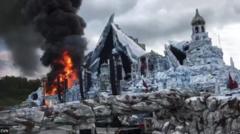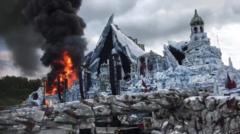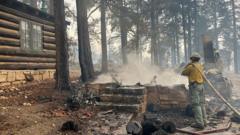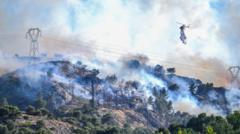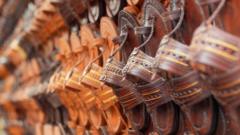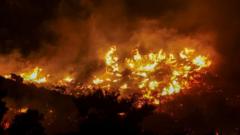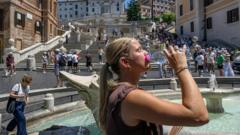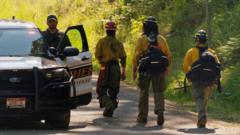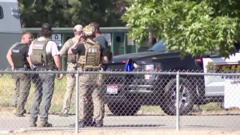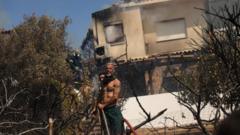The meticulous processes behind the smoke signals emphasize the balance between centuries-old customs and contemporary safety measures, ensuring clear and impactful communication during a pivotal moment for the Catholic Church.
**Smoke Signals from the Vatican: Engineering Tradition Through Fireworks**
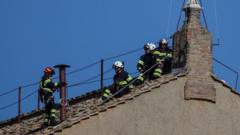
**Smoke Signals from the Vatican: Engineering Tradition Through Fireworks**
As the Vatican prepares for a new papal election, the ancient ritual of smoke signals showcases both tradition and modern engineering.
The Vatican is gearing up for the election of a new pope following the passing of Pope Francis. Instead of utilizing modern technology, the Church relies on a longstanding tradition of smoke signals from a chimney atop the Sistine Chapel. When a new pope is elected, white smoke will rise; if not, black smoke will indicate the necessity for further deliberation.
This ritual has evolved over centuries, grounded in practices that extend back to the 15th century. The use of smoke as a means of communicating the election results was established to prevent any tampering of ballots while ensuring transparency to the public. As dozens of cardinals gather at St. Peter's Basilica and the Sistine Chapel for the conclave, the world eagerly anticipates the smoke that signals either the selection of a new pope or the call for continued voting.
The logistical magnificence of the ritual is often overlooked. Inside the Chapel, technicians prepare two stoves specifically constructed for the conclave—one for burning the ballots and another for emitting smoke. These stoves are linked by a flue that runs through a newly installed chimney, crafted to not compromise the historical integrity of the chapel.
While preparations unfolded, the Vatican's firefighting teams stand vigilant just in case anything goes awry. The chimney's installation has been executed with precision and expertise, ensuring that both the stoves and chimney are meticulously sealed and tested. Kevin Farlam, a structural engineer, emphasized that any misstep could potentially harm the reputation of the Vatican, stating, “If one thing goes wrong, it’s not just a technical failure - it becomes an international incident.”
The smoke itself is carefully engineered as well. Modern advancements have replaced previous methods of creating smoke, which often led to ambiguity. Instead, precise chemical combinations are packaged in cartridges, ignited electronically to produce distinct black or white smoke. Black smoke results from burning a mix of potassium perchlorate and anthracene, while white smoke is crafted from potassium chlorate and pine rosin.
Despite suggestions to modernize the process with digital alerts or colored lights, the Vatican remains steadfast in preserving its rich traditions. For them, this ritual encapsulates not only communication of monumental significance but also a connection to centuries of established religious traditions. As Candida Moss, a theology professor, articulated, “This is about tradition and secrecy, but it has real theological heft to it as well.”
The blend of history and modernity during the Vatican's papal election underscores the intricate relationship between maintaining legacy and embracing necessary advancements without compromising the sacredness of the ritual. As the world watches, the smoke from the Vatican will bring together centuries of faith in a single, powerful signal.
This ritual has evolved over centuries, grounded in practices that extend back to the 15th century. The use of smoke as a means of communicating the election results was established to prevent any tampering of ballots while ensuring transparency to the public. As dozens of cardinals gather at St. Peter's Basilica and the Sistine Chapel for the conclave, the world eagerly anticipates the smoke that signals either the selection of a new pope or the call for continued voting.
The logistical magnificence of the ritual is often overlooked. Inside the Chapel, technicians prepare two stoves specifically constructed for the conclave—one for burning the ballots and another for emitting smoke. These stoves are linked by a flue that runs through a newly installed chimney, crafted to not compromise the historical integrity of the chapel.
While preparations unfolded, the Vatican's firefighting teams stand vigilant just in case anything goes awry. The chimney's installation has been executed with precision and expertise, ensuring that both the stoves and chimney are meticulously sealed and tested. Kevin Farlam, a structural engineer, emphasized that any misstep could potentially harm the reputation of the Vatican, stating, “If one thing goes wrong, it’s not just a technical failure - it becomes an international incident.”
The smoke itself is carefully engineered as well. Modern advancements have replaced previous methods of creating smoke, which often led to ambiguity. Instead, precise chemical combinations are packaged in cartridges, ignited electronically to produce distinct black or white smoke. Black smoke results from burning a mix of potassium perchlorate and anthracene, while white smoke is crafted from potassium chlorate and pine rosin.
Despite suggestions to modernize the process with digital alerts or colored lights, the Vatican remains steadfast in preserving its rich traditions. For them, this ritual encapsulates not only communication of monumental significance but also a connection to centuries of established religious traditions. As Candida Moss, a theology professor, articulated, “This is about tradition and secrecy, but it has real theological heft to it as well.”
The blend of history and modernity during the Vatican's papal election underscores the intricate relationship between maintaining legacy and embracing necessary advancements without compromising the sacredness of the ritual. As the world watches, the smoke from the Vatican will bring together centuries of faith in a single, powerful signal.


